
Forest composition and forest site types
History of forest formation and forestry
The prevailing tree species on Hiiumaa, according to the dominant tree species, is pine (43%), followed by birch (33%), common alder (11%) and spruce (10%). Other tree species constitute only 3% according to the dominant tree species. (Eesti Metsakorralduskeskus 1998) Aspen, ash, lime and oak represent only an insignificant part of the island's forests. (Environmental Service)
As listed below, the figures derived from state owned forests show a considerably higher amount of pine, whereas common alder and birch occur much less in these areas.
| Pine | Birch | Spruce | Common alder | Other | |
| Total | 43% | 33% | 10% | 11% | 3% |
| State | 71% | 18% | 9% | 1% | 1% |
Sources:
Eesti Metsakorralduskeskus 1998; Environmental Service
Based upon the general classification system of Estonian
Forest Site Types, developed by the National Forestry Board, within ten
groups of types different site types can be identified in Hiiumaa. Although
this classification system is mostly used in forestry, a broader and more
detailed system is in use for the classification of Estonian vegetation.
It is presumed that in future the first system will be implemented in
the latter.
The
following diagram illustrates the composition of the forests on Hiiumaa
by groups of site types, according to the conventional system, on mineral
soil (first 7 groups) and peat land.

Source: Eesti
Metsakorralduskeskus 1998
The spatial distribution of groups of types on Hiiumaa is shown on this
map.
**Eesti Metsakorralduskeskus, 1998, Hiiumaa
Statistiline Metsainventeerimine, Tallinn, 62 p.
Different groups of site types on Hiiumaa:
- Alvar forests
- Heath forests
- Mesotrophic (pine) forests
- Meso-eutrophic (spruce) forests
- Nemoral forests
- Herb-rich mixed forests on wet gley soils
- Dwarf-shrub-Sphagnum paludified forests
- Grass fen forests
- Bog moss forests
- Full-drained swamp forests
Alvar forests
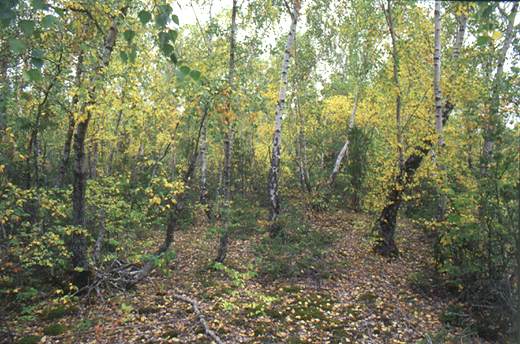
The main area of distribution of alvar forests on Hiiumaa is the coastline, especially those facing the north and the southern coastline of Kassari. Their relatively low occurrence in entire Estonia makes their presence on the island even more valuable.
Alvar forests are characterised by their thin mineral soil layer (maximum thickness up to 30 centimetres) upon rather solid limestone, shingle or gravel layers. Their productivity is relatively low and prospects for forestry become even more unfavourable considering the coarse a-biotic conditions of the island. The roots of the trees penetrate the thin layer of soil and push directly into the crevices of the limestone rock. Nevertheless, strong winds tear off the pieces of limestone together with the roots.
Of the three site types within this group the small reed (Calamagrostis) alvar (pine) forest is prevailing on Hiiumaa. The mineral soil layer has a thickness of 10 to 30 centimetres only. Therefore lack of moisture is the main factor limiting the growth and regeneration of this type of forests. Most of the alvar site types have a varied undergrowth and ground vegetation.
**Estonian Forest Department, 1995, Estonian Forests and Forestry, Tallinn, 128 p.
Heath forests
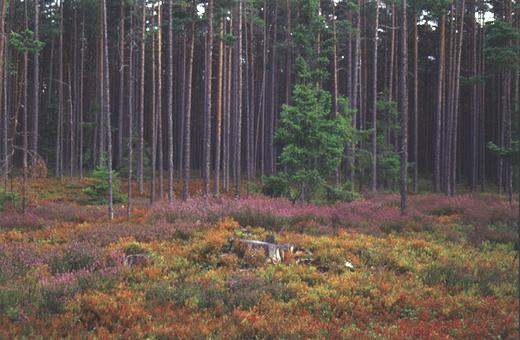
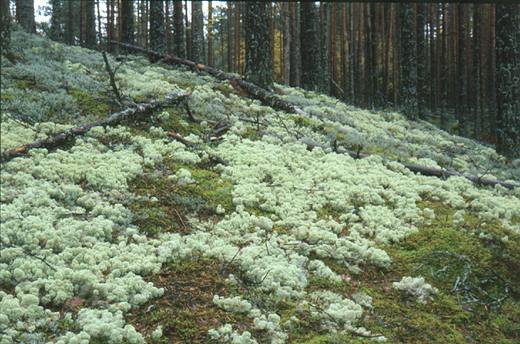
Heath forests occur mainly in the northern and western parts of Hiiumaa.
They consist of pine stands, sometimes mixed with birch, and they grow on poor sandy, more or less podzolized podzols. On Hiiumaa heath forests have great importance for soil protection on coastal dunes. Heath forests are quite fragile, also due to their slow development and low productivity.
The undergrowth in the forests of this site type is poor and consists mainly of some sparse junipers.
**Estonian Forest Department, 1995, Estonian Forests and Forestry, Tallinn, 128 p.
Mesotrophic (pine) forests
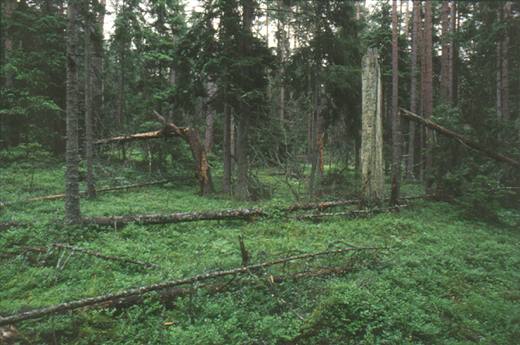
This is the second largest group of types on Hiiumaa and like the heath forests, it is mainly occurring in the northern and western parts of the island, though they occur more inland.
As the name suggests, the composition of the tree layer in these forests mainly consists of pine, in the more fertile soils alternated by spruce. Most often the podzolized or podzolized podzol soils are relatively fertile and formed on a sandy layer or sands on moraine. The stands are of average productivity. The prevailing site type on Hiiumaa is the bilberry (Myrtillus) site type. The texture of the soil and especially the thickness of the moraine layer cause large differences in the appearance of these forests. Therefore five sub-types are used to identify a forest. Undergrowth in this group of types is mostly absent and ground vegetation consists of a few species.
**Estonian Forest Department, 1995, Estonian Forests and Forestry, Tallinn, 128 p.
Meso-eutrophic (spruce) forests
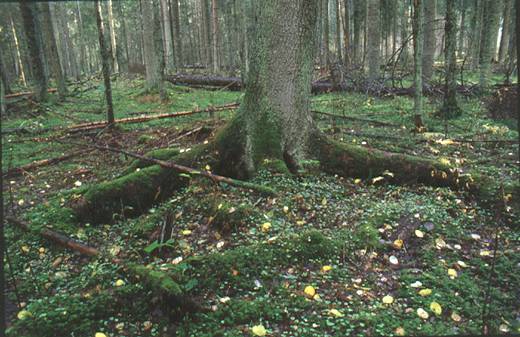
This group of types, although to a very small extent, has a rather equal distribution on the island of Hiiumaa.
Predominant species is spruce, growing on fertile soils, mostly formed on loamy moraines. Birch and pine forests occur in about one third of the meso-eutrophic forests. The stands are very productive as a result of favourable moisture and nutrition conditions. Undergrowth and ground vegetation are very rich in species.
**Estonian Forest Department, 1995, Estonian Forests and Forestry, Tallinn, 128 p.
Nemoral forests
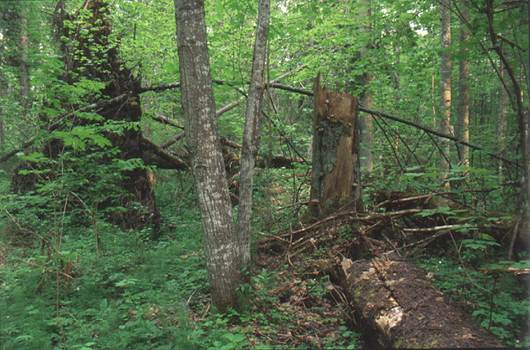
Some areas of nemoral forests can be found in the southern and eastern part of the island.
Favourable moisture conditions and very fertile soils create the opportunity even for the most demanding tree species to settle in one of the site types within this group of types. Both the undergrowth and the ground vegetation, nemoral plants included, are rich in species too. Remarkable, however, is the lack of dwarf shrub layer.
The majority of trees are of deciduous species like birch, grey alder, aspen, and black alder. Spruce is the most occurring coniferous species.
The thick humus layer, rich in humus, is another characteristic feature of nemoral forests. The soil type ranges from gleyed podzolic to peaty soils and fluvisols. (Estonian Forests and Forestry, 1995)
On Hiiumaa the prevailing site type within this group of types is the goutweed (Aegopodium) site type.
Herb-rich mixed forests on wet gley soils
This most frequent group of site types is rather equally distributed on the island of Hiiumaa. Only on the northern and western peninsulas the areas of these site types occur to a lesser extent.
Meadowsweet (Filipendula) and sedge-meadowsweet (Carex-Filipendula) are the most common site types on Hiiumaa. Like most site types within this group, both these site types are located on peaty soils, which periodically suffer from overmoisture. The species that compose these mixed forests are birch, pine, grey and black alder and spruce. Due to the unfavourable moisture conditions, their productivity is moderate to low.
Characteristic to most of the site types is the undulating micro-relief. Undergrowth and ground vegetation, herbs and moss included, are relatively rich.
**Estonian Forest Department, 1995, Estonian Forests and Forestry, Tallinn, 128 p.
Dwarf-shrub-Sphagnum paludified forests
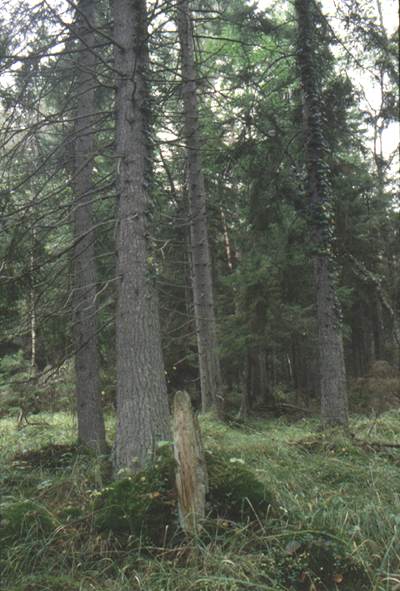
The group and the preceding one were united in the site type composition diagram because of their low occurrence.
Pine is the predominant tree species on the acid, overmoistured podzolic soils. Birch and spruce occur less frequently. The negative conditions cause a low productivity. There is hardly any undergrowth and dwarf shrubs dominate the ground vegetation. Considerable amounts of bog and hair moss represent the continuous moss layer.
**Estonian Forest Department, 1995, Estonian Forests and Forestry, Tallinn, 128 p.
Grass fen forests
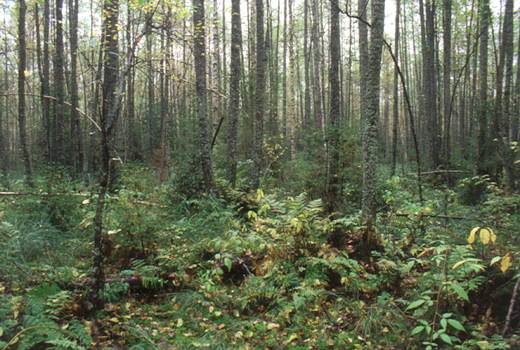
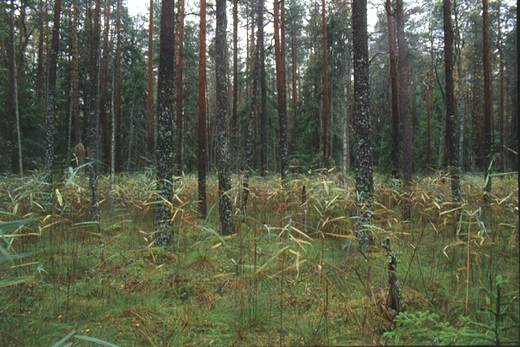
Grass fen forests occur mainly in central and eastern Hiiumaa.
The tree storey contains swamp birch and black alder, which grow on wet fen soils.
Both the forests of the alder fen site type and those of the birch fen site type are dominated by swamp birch, followed by black alder. Spruce and pine forests occur as well.
The main difference between the two site types is the fertility of the soil. This results in a moderate productivity in the alder fen site type and a low productivity in the birch variant. Another remarkable difference can be found in the undergrowth. That of the first-mentioned site type is rich in species, whereas that of the latter is sparse.
**Estonian Forest Department, 1995, Estonian Forests and Forestry, Tallinn, 128 p.
Bog moss forests
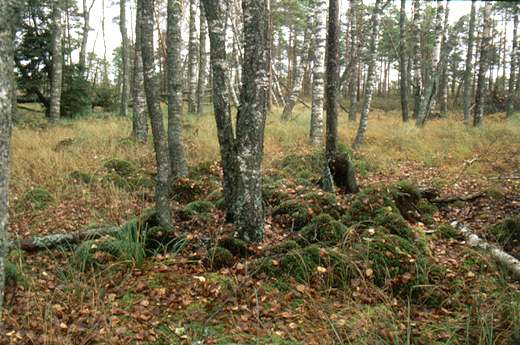
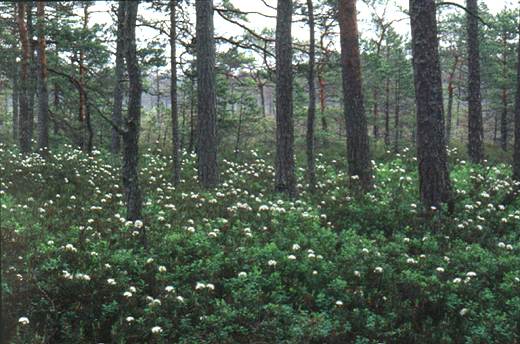
This group of types is prevailing in the central part of the island.
Prevailing tree species is pine, growing on a layer of bog peat. The share of birch and spruce is much smaller. Productivity in bog moss forests is low, though in many cases increased by drainage activities. The undergrowth is not too rich and the ground vegetation is dominated by bog moss and dwarf shrubs. (Estonian Forests and Forestry, 1995) Transition bog is the prevailing site type on Hiiumaa.
Full-drained swamp forests
The areas of full-drained swamp forests occur mainly in the central part of Hiiumaa.
The intensively drained bog soils in this group of types often possess ground vegetation comparable to that of forests on mineral soils. The drainage process accelerates the decomposition of peat, which favours the nutritional conditions for the forests.
Birch and pine are prevailing, spruce occurs to a lesser extent. The composition of the undergrowth and ground vegetation is often comparable to that of site types of the same name on mineral soils.
**Estonian Forest Department, 1995, Estonian Forests and Forestry, Tallinn, 128 p.
Estonians have traditionally had a strong relation to forests. Also on Hiiumaa, forests and forestry have since long played an important role in the lives of the island inhabitants.
The oldest part of Hiiumaa is Kõpu peninsula. About 10, 000 years ago a small, horseshoe shaped islet appeared above sea level as a result of tectonical movements of the earth. (picture)
This small island in the middle of the sea was open to strong sea winds. The winds and waves piled huge sanddunes around the island. Today these ancient dunes and coastal formations characterise the landscape around Kõpu, while Hiiumaa as a whole is a flat lowland, which gradually emerged from the sea during the last four millennia. (Rebastemägi Nature Path, 1998)
Forest formation on what already existed of the current Hiiumaa started about 8 000 years ago in the Boreal climatic period. Small hazel tree–pine forests appeared on the islet.
Later on, in the Atlantic period, most of the pine was exchanged for many species of broad-leafed trees. Oak-pine mixed forests were alternated by lime-elm deciduous forests, alder and birch forests appeared in the lower parts of the island and at the end of this period oak-spruce mixed forests appeared.
In the Sub-Boreal period the broad-leafed forests withdrew and heath-, mesotrophic- and nemoral pine forests, swamp birch and alder dominated the landscape. Spruce forests and mixed spruce forests also had a widespread distribution.
The current pine, birch, alder and spruce forests appeared during the Sub-Atlantic period. The most frequent site types are woodsorrel-, fern- and Hepatica forest. Small valuable deciduous trees gained importance. Finally in this period the semi-natural associations like hay-woodland and coastal forests appeared. (Environmental Atlas of Hiiumaa Island I, 1995)
The first signs of burnt-over clearings date from the beginning of our era. Several prohibitions had to put an end to the intensive use of both private and common forests during the Middle Ages.
The completion of the Kõpu lighthouse in 1530 was disastrous for its surroundings; to keep the fire burning huge amounts of wood were supplied. The beginning of trade and export of forest material from the island and some industries, like glass burning, tar- and brick industry and ship building caused further exhaustion of the forests on Hiiumaa.
From the middle of the XVII century forestry gradually became more controlled by several restrictions and laws concerning the sale of forest material, forest management, location of clear cuttings and grazing of cattle in forests.
Some remarkable events in the last century are the large forest fire in 1940 in the surroundings of Kärdla, which destroyed about 1 000 hectares of woodlands and the destruction of 24 thousand cubic metres of wood all over the island, caused by a heavy storm in 1967. (Environmental Atlas of Hiiumaa Island II, 1999)
**Hiiumaa Keskkonnaatlas I, 1995, Environmental Atlas of Hiiumaa Island, General map of the Natural Environment, Hiiumaa Centre of the West-Estonian Archipelago Biosphere Reserve
**Hiiumaa Keskkonnaatlas II, 1999, Environmental Atlas of Hiiumaa Island, General map of the Forests, Hiiumaa Centre of the West-Estonian Archipelago Biosphere Reserve
Photos: Tiit Leito
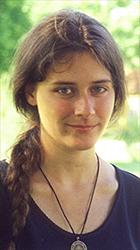
Prepared by Floor Vodde,
student from the Department of Forestry,
Wageningen Agricultural University,
The Netherlands during her practical training
on Hiiumaa in summer 2000.